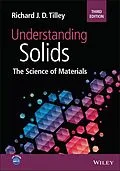Explore a comprehensive and illuminating introductory text to the science of solid materials from a leading voice in the field
The newly revised Third Edition of Understanding Solids: The Science of Materials delivers a complete yet concise treatment of the basic properties and chemical and physical behaviors of solid materials. Following a completely revised opening set of chapters in which the basic properties of solids--including atomic structure, chemical bonding, crystallography, and phase relationships--are discussed, the book goes on to describe new developments in the areas of batteries and fuel cells, perovskite solar cells, lighting and displays, nanoparticles, whiskers, and sheets.
The distinguished author has also added sections about organic framework structures, superionic conductors, mechanochemistry, bi-layer graphene, hologram formation and recording, and the optics of nanoparticle arrays and thermochromic materials. Each chapter includes a Further Reading section to help students accumulate additional knowledge on the topic within and new problems have been added throughout the book. Readers will also enjoy the inclusion of:
* A thorough introduction to the states of aggregation, including atoms and bonding, microstructures and phase relationships, and crystal structures and defects
* A comprehensive overview of different categories of solids, including metals, crystalline silicates, inorganic ceramics, and silicate glasses
* An exploration of reactions and transformations, including diffusion and ionic conductivity, phase transformations, and phase reactions
* A treatment of oxidation and reduction, including galvanic cells and chemical analysis
Perfect for undergraduate students in sciences, engineering, and technology, Understanding Solids: The Science of Materials will also earn a place in the libraries of anyone seeking a thoroughly up to date, one-stop reference to the science of solid materials.
Autorentext
Richard J.D. Tilley [INFO NOT INCLUDED]
Preface xix Part I States of Aggregation 1 1 Atoms and Bonding 3 1.1 The Electron Structure of Atoms 3 1.1.1 Hydrogen 3 1.1.2 Many Electron Atoms 4 1.1.3 Orbital Shapes 6 1.1.4 Electron Spin and Electron Configuration 8 1.1.5 Atomic Energy Levels 9 1.2 Ionic Bonding 12 1.2.1 Ionic Size and Bonding 12 1.2.2 Lattice Energies 13 1.2.3 Atomistic Simulation 14 1.3 Covalent Bonding 15 1.3.1 Bond Geometry 15 1.3.2 Bond Energies 18 1.4 Metallic Bonding 21 1.4.1 Molecular Orbitals and Energy Bands 21 1.4.2 The Free Electron Gas 22 1.4.3 Energy Bands 24 1.4.4 Bands in Ionic and Covalent Solids 27 1.5 Weak Chemical Bonds 28 1.6 Computation of Material Properties 31 Further Reading 31 The Following References Expand the Material in this Chapter 31 A Dictionary of Quantum Mechanical Language and Expressions is 32 Ionic Radii are Discussed and Tabulated by 32 The Computation of Properties is Described in 32 Problems and Exercises 32 Calculations and Questions 34 2 Microstructures and Phase Relationships 37 2.1 Macrostructure, Microstructure, and Nanostructure 37 2.1.1 Crystalline Solids 37 2.1.2 Non-crystalline Solids 37 2.1.3 Partly Crystalline Solids 40 2.1.4 Nanoparticles and Nanostructures 40 2.2 The Development of Microstructures 43 2.2.1 Solidification 43 2.2.2 Processing 44 2.3 Phase Diagrams 45 2.3.1 One-Component (Unary) Systems 45 2.3.2 Two-Component (Binary) Systems 48 2.3.2.1 Simple Binary Diagrams: NickelCopper as an Example 48 2.3.2.2 Binary Systems Containing a Eutectic Point: TinLead as an Example 49 2.3.2.3 Intermediate Phases 52 2.3.2.4 The IronCarbon System Close to Iron 52 2.4 Ternary Systems 54 References 57 Further Reading 58 Problems and Exercises 58 Calculations and Questions 60 3 Crystal Structures and Defects 65 3.1 Crystal Geometry 65 3.1.1 Crystal Systems 65 3.1.2 Crystal Lattices 66 3.1.3 Symmetry and Crystal Classes 68 3.2 Crystal Structures 69 3.2.1 Unit Cells and Atomic Coordinates 69 3.2.2 Crystal Structures 70 3.2.2.1 The Face-Centred Cubic (fcc, A1) Structure 70 3.2.2.2 The Body-Centred Cubic (bcc, A2) Structure 70 3.2.2.3 The Hexagonal Close-Packed (hcp, A3) Structure 70 3.2.2.4 The Diamond Structure 71 3.2.2.5 The Graphite Structure 71 3.2.2.6 The Halite (Rock Salt, Sodium Chloride) Structure 71 3.2.2.7 The Perovskite Structure 72 3.2.2.8 The Spinel Structure 72 3.2.2.9 Lattice Parameters and Vegard's Law 74 3.3 Crystal Planes and Directions 74 3.3.1 Miller Indices 74 3.3.2 Hexagonal Crystals and MillerBravais Indices 76 3.3.3 Directions 78 3.3.4 Interplanar Spacings 79 3.4 Crystal Density 80 3.4.1 Density Estimation 80 3.4.2 The Density of NaCl 81 3.4.3 The Density of Crystals with a Variable Composition 81 3.5 Structural Relationships 82 3.5.1 Sphere Packing 82 3.5.2 Ionic Structures in Terms of Anion Packing 84 3.5.3 Polyhedral Representations 86 3.6 Point Defects 87 3.6.1 Point Defects in Crystals of the Elements 88 3.6.2 Solid Solutions 89 3.6.3 The Schottky and Frenkel Defects 90 3.6.4 Non-stoichiometric Compounds 91 3.6.5 Point Defect Notation 93 3.7 Linear, Planar, and Volume defects 95 3.7.1 Dislocations 95 3.7.2 Planar Defects 96 3.7.3 Volume Defects: Precipitates 99 Reference 99 Further Reading 100 Crystal Structures 100
Inhalt
